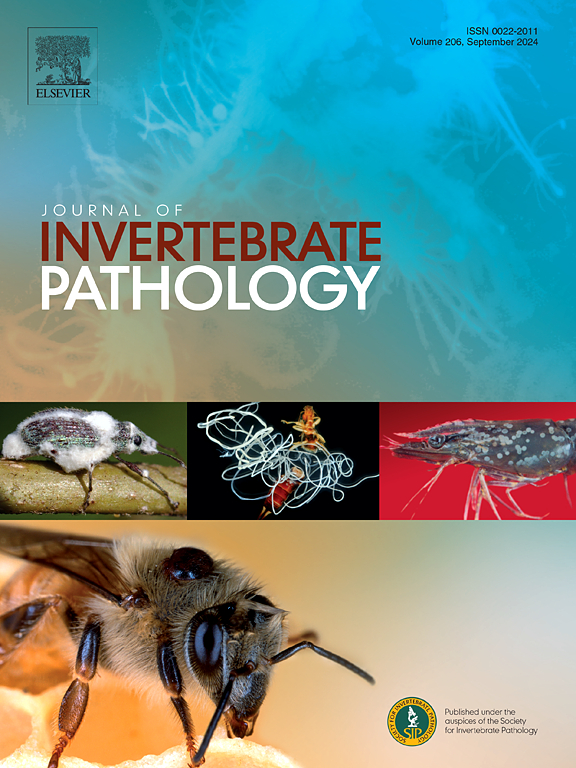Dynamics of Israeli acute paralysis virus in the red imported fire ant (Solenopsis invicta Buren) colonies
IF 2.4
3区 生物学
Q1 ZOOLOGY
引用次数: 0
Abstract
The red imported fire ant, Solenopsis invicta Buren, is one of the most significant pest ants in the southern United States, frequently found in honey bee colonies and their surrounding areas. While fire ants scavenge on dead bees and may function as secondary hosts or reservoirs for several honey bee-associated viruses, evidence of viral dynamics and persistence in fire ant colonies has been inconclusive. In this study, we conducted a series of experiments to test the possibility of food-borne virus transmission i.e. horizontal transmission from virus-infected honey bee pupae to fire ants and persistence of the virus within the fire ants’ colonies. Israeli acute paralysis virus (IAPV) was used as an experimental pathogen due to its relevance to honey bee health and its limited prevalence. Our results showed that fire ants can acquire IAPV horizontally by consuming virus-infected honey bees. The virus may spread rapidly across all developmental stages (larvae, pupae, and workers) within the colony, likely facilitated by the social interactions. Additionally, fire ant queens can likely acquire the virus via trophallaxis and/or physical contact with workers. Our results further indicated that IAPV could be transmitted vertically, however confirmatory research is required. Monitoring the virus after 4 months of inoculation confirmed that a significant IAPV load persists in all developmental stages of colony members. These findings suggest that fire ants can act as virus reservoirs for a deadly honey bee-associated virus, posing a potential threat to the health and well-being of bee pollinators.

以色列急性麻痹病毒在进口红火蚁蚁群中的动态。
红火蚁(Solenopsis invicta Buren)是美国南部最重要的害虫之一,经常出现在蜜蜂群落及其周围地区。虽然火蚁以死去的蜜蜂为食,并可能作为几种蜜蜂相关病毒的次级宿主或宿主,但火蚁群体中病毒动力学和持久性的证据尚无定论。在这项研究中,我们进行了一系列实验来测试食源性病毒传播的可能性,即从感染病毒的蜜蜂蛹向火蚁的水平传播以及病毒在火蚁群体中的持久性。以色列急性麻痹病毒(IAPV)由于其与蜜蜂健康的相关性和有限的流行率而被用作实验病原体。结果表明,火蚁可以通过吞噬感染病毒的蜜蜂水平获取IAPV。该病毒可在蜂群内的所有发育阶段(幼虫、蛹和工蜂)迅速传播,这可能是由社会互动促成的。此外,火蚁女王可能通过滋养和/或与工蚁的身体接触获得病毒。我们的结果进一步表明,IAPV可以垂直传播,但还需要进一步的验证研究。接种4 个月后的病毒监测证实,在群体成员的所有发育阶段都持续存在显著的IAPV负荷。这些发现表明,火蚁可以作为一种致命的蜜蜂相关病毒的病毒宿主,对蜜蜂传粉者的健康和福祉构成潜在威胁。
本文章由计算机程序翻译,如有差异,请以英文原文为准。
求助全文
约1分钟内获得全文
求助全文
来源期刊
CiteScore
6.10
自引率
5.90%
发文量
94
审稿时长
1 months
期刊介绍:
The Journal of Invertebrate Pathology presents original research articles and notes on the induction and pathogenesis of diseases of invertebrates, including the suppression of diseases in beneficial species, and the use of diseases in controlling undesirable species. In addition, the journal publishes the results of physiological, morphological, genetic, immunological and ecological studies as related to the etiologic agents of diseases of invertebrates.
The Journal of Invertebrate Pathology is the adopted journal of the Society for Invertebrate Pathology, and is available to SIP members at a special reduced price.

 求助内容:
求助内容: 应助结果提醒方式:
应助结果提醒方式:


